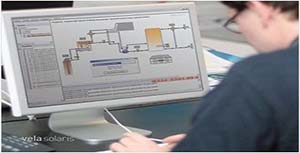There is some debate over the merits of a drain back style solar water heating system versus a closed loop glycol solar water heating system. Both have their merits and both will do the job of heating hot water. However in Canada and the Northern USA we do not supply or recommend drain back systems with evacuated tube collectors. Here are the reasons we feel a closed loop solar heating system is better than a drain back system in freezing climates.
What is a drain back system?
A drain back system uses water as its heating method not glycol. The water in the system is in an open loop and as such drains itself via gravity back to a storage vessel when it has reached it shut off temperature or is too cold. This is how the system handles both overheating and freezing. In the evening when there is no solar gain to be had, the system activates a drain solenoid that drains the water in the collectors down to a smaller storage tank called the drain back tank located in the basement or utility room. In this type of system water is not left in the collect as it has been drained. When the solar collector has energy to deliver, a pump is activated and pumps the water through the heating system. In the event of overheating, the system will drain itself, so no water is in the collectors to be over heated.
What is a closed loop system?
A closed loop or sometimes known as an “active” solar system uses a mixture of glycol and water and is pressurized with in the system. This requires a pump station to fill the system initially (all our solar water heating kits come with the fill pump). The system is pressurized to between 20-30 psi. In a closed loop system, an expansion tank with a rubber membrane is present and absorbs the expanding and contracting of the heating system as it heats up and cools. Hydronic in floor heat is a good example of a closed loop system as is any boiler system. Because glycol is used in the system, the heating fluid can be left outside without worrying about freezing. A closed loop system handles overheating by shutting off the circuiting pump and forcing the system into what is known as “Stagnation”. In this state the heating fluid in the collector turns to steam and this added volume of steam is absorbed in the system by the rubber membrane in the expansion tank.
Advantages
The drain back has an advantage in that is uses water as the heating fluid. Water has a slightly better heat co-efficient of performance than glycol and as such can produce slightly more heat energy than a system with glycol. However, on the other side a closed loop system once installed has very little maintenance. Because the glycol/water is in a separate loop, it is not affected by oxygen and does not evaporate. A closed loop system also has no vertical head pressure to overcome as it is not affected by the forces of gravity that an open loop or drain back system must overcome. Thus, the pump requires less energy increasing the efficiency.
Disadvantage
A solar vacuum tube gets very hot and can reach 300 C. This becomes an issue in a drain back system where water is filled and drained in a system based on the heat in the collector. If the collector was filled when it is too hot, it would instantly flash the water to steam as it enters the collector. For this reason, drain back are typically found with flat panel collectors that do not reach the high temperatures that vacuum tubes can achieve.
A drain back system has critical weakness in cold climates. It relies on a mechanical valve to open and close the system to drain itself. Any mechanical item is prone to failure and a failure of a drain back system in freezing climates would result in nearly total loos as the collector and piping would be completely destroyed by the expanding ice. For this reason, we feel the risk of damage is too great to overcome the small advantages of a drain back system and as such we do not offer any type of drain back solar water heating systems.



